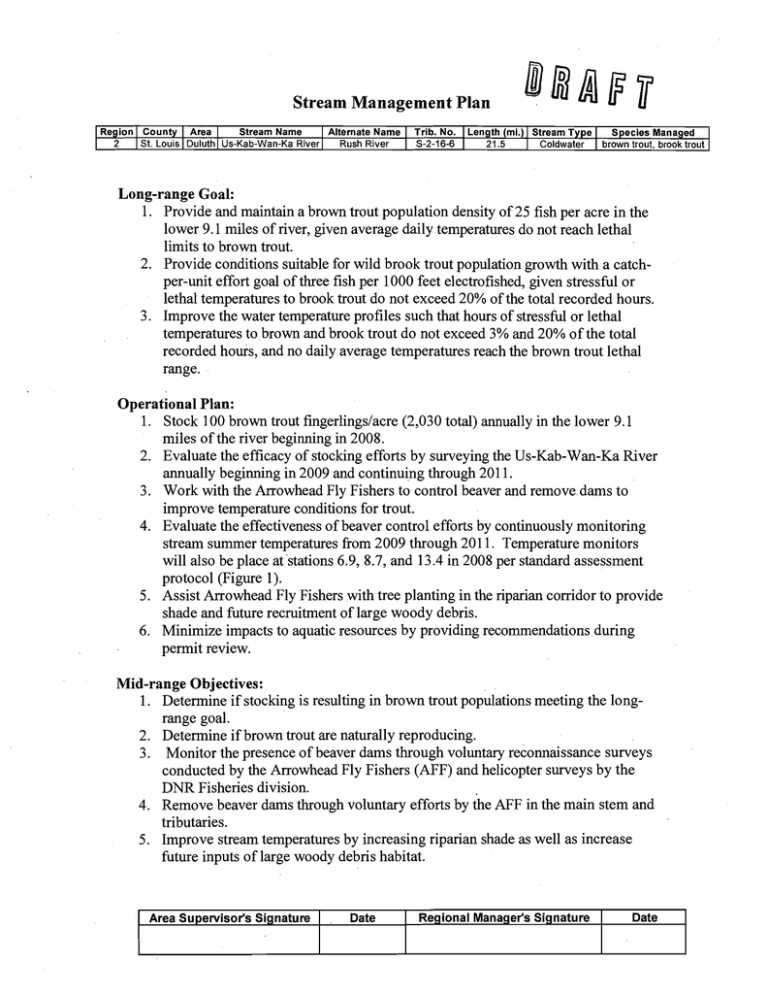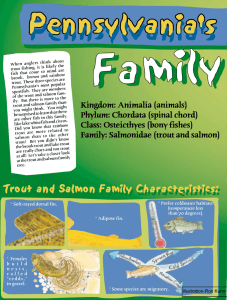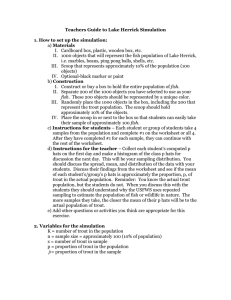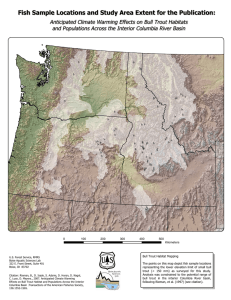Draft Stream Management Plan - US-Kab-Wan-Ka River
advertisement

Stream Management Plan I I Stream Name Region I County Area I I Alternate Name 2 1 St. Louis ~ u l u t hUs-Kab-Wan-Ka l River 1 Rush River I 1 Trib. No. S-2-16-6 B@PP~ I Length (mi.) I Stream Type I Species Managed 1 21.5 1 Coldwater I brown trout, brook trout Long-range Goal: 1. Provide and maintain a brown trout population density of 25 fish per acre in the lower 9.1 miles of river, given average daily temperatures do not reach lethal limits to brown trout. 2. Provide conditions suitable for wild brook trout population growth with a catchper-unit effort goal of three fish per 1000 feet electrofished, given stressful or lethal temperatures to brook trout do not exceed 20% of the total recorded hours. 3. Improve the water temperature profiles such that hours of stressful or lethal temperatures to brown and brook trout do not exceed 3% and 20% of the total recorded hours, and no daily average temperatures reach the brown trout lethal range. Operational Plan: 1. Stock 100 brown trout fingerlingslacre (2,030 total) annually in the lower 9.1 miles of the river beginning in 2008. 2. Evaluate the efficacy of stocking efforts by surveying the Us-Kab-Wan-Ka River annually beginning in 2009 and continuing through 201 1. 3. Work with the Arrowhead Fly Fishers to control beaver and remove dams to improve temperature conditions for trout. 4. Evaluate the effectiveness of beaver control efforts by continuously monitoring stream summer temperatures from 2009 through 201 1. Temperature monitors will also be place at stations 6.9, 8.7, and 13.4 in 2008 per standard assessment protocol (Figure 1). 5. Assist Arrowhead Fly Fishers with tree planting in the riparian corridor to provide shade and future recruitment of large woody debris. 6. Minimize impacts to aquatic resources by providing recommendations during permit review. Mid-range Objectives: 1. Determine if stocking is resulting in brown trout populations meeting the longrange goal. 2. Determine if brown trout are naturally reproducing. 3. Monitor the presence of beaver dams through voluntary reconnaissance surveys conducted by the Arrowhead Fly Fishers (AFF) and helicopter surveys by the DNR Fisheries division. 4. Remove beaver dams through voluntary efforts by the AFF in the main stem and tributaries. 5. Improve stream temperatures by increasing riparian shade as well as increase future inputs of large woody debris habitat. Area Supervisor's Signature Date Regional Manager's Signature Date Stream Us-Kab-Wan-Ka Tributary S-2-16-6 Date 2007 Potential Plan: Create quality instream habitat suitable to trout, given water temperatures reach the aforementioned long-range goal. Narrative: The Us-Kab-Wan-Ka River originates from Rush Lake and wetland seepage and flows for 2 1.5 miles before entering the Cloquet River northwest of Duluth, Minnesota. The stream lies in an area of stratified glacial drift known as the Toimi drumlin field, with soil types of gravellclay and a gradient of 11 feetlmile. Land usage within the watershed is 50% brushland, 28% marshland, and 22% forestland. Cover types adjacent to the stream are 89% shrubs, 9% forests, and 2% grasses. Land ownership adjacent to the river is 90% county tax forfeit and 10% private. Past Surveys and Investigations: Population Assessments - 1965, 1984,2006 Temperature Assessments - 2002,2004,2005,2006 Fall Beaver Dam Assessments - 2006 and 2007 Special Surveys - The Minnesota Department of Conservation (now the DNR) conducted a survey between 1942 and 1945 to determine the presence and future potential of trout streams in the St. Louis River basin. Results of the study (including the Cloquet River) were presented in the 1947 Fisheries Research Unit Investigational Report #69: A biological survey andjshery management plan for the streams of the St. Louis River basin (Moyle and Kenyon 1947). Electrofishing surveys conducted between 1965 and 2006 collected twelve fish species in Us-Kab-Wan-Ka River (Figure 1, Table 1). Past Management: The Us-Kab-Wan-Ka River has received little management other than standard bag and size limits for trout. Trout stocking reportedly occurred from 1914 through the late 1940's, although no records of specific species, numbers, or sizes of stocked fish exist. The Cloquet River was stocked with yearling brown trout in 1975, 1977-1981, and 20022007. Historic anecdotal reports suggest anglers did catch brown trout in the past, but have never been sampled in fisheries surveys. Adult brook trout up to 230 mm were sampled in small numbers in the 1984 and 2006 assessments as far upstream as mile 5.0. Warm water gamefish including northern pike and smallmouth bass were sampled up to mile 10.2. Northern pike and smallmouth bass sampled were scarce, small in size, and likely the result of adult migration from the Cloquet River or Bergen Lake into Us-KabWan-Ka to spawn. Water temperatures from 2002-2006 indicate that the thermal regime of the Us-KabWan-Ka River was approaching andlor exceeding the upper temperature tolerance threshold for brook trout. The mean percentage of time water temperatures were within and above the range of thermal stress for brook trout was between 26% and 42% (Table Stream Name I Tributary No. Date Us-Kab-Wan-Ka River S-2-16-6 2007 2). Therefore, brook trout are likely experiencing reduced growth and increased mortality during thermally stressful ~ e a water n temperatures were more conducive to supporting brown trout populations, with stressful temperatures occurring less than 15% of the time (Table 3). Stream and Watershed Alterations: In 1912, the Duluth, Winnipeg & Pacific Railway was completed and connected Duluth with several other railway interchanges. This railway is still in use and runs adjacent to and over the Us-Kab-Wan-Ka River. Other than logging, little human alteration of the watershed has taken place because the river lies within the Cloquet Valley State Forest. Beaver activity in the Us-Kab-Wan-Ka river watershed is of special concern. Beaver dams block fish migration, increase water temperatures, and deteriorate habitat preferable to trout. A total of 33 dams were located during a 2006 aerial survey. Limiting Factors: Warm water temperatures and low flow limit trout abundance in the Us-Kab-Wan-Ka River, in part due to beaver dams. Dams reduce flows by creating standing water that is susceptible to evaporation. Social Considerations: The entire 21.5-mile reach of Us-Kab-Wan-Ka is a designated trout stream and all but' approximately 4,000 feet is on public land; Given its proximity to Duluth and potential to maintain brook and brown trout populations, the Us-Kab-Wan-Ka river should be considered a very valuable resource. Although not yet collected in the Us-Kab-Wan-Ka river, the exotic species Bythotrephes cederstroemi, commonly known as the spiny water flea has been found downstream in the Cloquet River. Survey Needs and Evaluation Plan: 1. Beginning in 2009, conduct annual population assessments to monitor the survival and distribution of stocked fingerling brown trout, and to document potential natural production. Assessments would end in 20 1 1 and the management plan evaluated to determine whether long-range goals were reached. 2. . Deploy continuous recording thermometers from 2009-201 1 to assess water temperature changes resulting from beaver dam removal. 3. Work annually with AFF volunteers monitoring beaver activity to determine efficacy of beaver control strategies. Land Acquisition Needs: Maintain public ownership of land within the watershed. Stream Name Us-Kab-Wan-Ka River I Tributary No. Date S-2-16-6 2007 Habitat Development Needs: 1. Remove beaver dams through a voluntary effort by the AFF, with dams in the main stem the first priority and tributaries the. second priority. 2. Plant coniferous tree species unfavorable to beaver in the riparian area to provide shade and reduce water temperature. Habitat Protection Needs: 1. Minimize impacts to aquatic resources by providing recommendations during permit review. 2. Work with St. Louis County and MN DNR forestry departments on timber sales affecting riparian areas by utilizing Forest Resource Council site level guidelines. Stocking: Annual stocking of 2,030 brown trout fingerlings will begin in 2008 to provide an instream fishery, as well as to provide seed trout for angling opportunities in the Cloquet River. Regulations: Maintain status as designated trout stream. 1 Table 1. Species sampled in the Us-Kab-Wan-Ka River, 1947-2006. 1947* 1965 1984 2006 Species SA PA PA PA Blacknose dace X X X Bluegill X X Brook trout X X Central mudminnow X X Common shiner X I X Creek chub I X X Johnny darter 1 1 X ! - ~ " - Mottled sculpin Northern Pike Smallmouth Bass White sucker - - X X X X X X X X ' Survey type: FS=Full Survey, PA=Population Assessment, SA=Special Assessment * no trout were seined during the survey, and other species were not recorded Table 2. Summary of Us-Kab-Wan-Ka River water temperature data ("F) obtained at miles 0.2, 1.7, 3.1, 6.9,8.7 and 13.4 between June 1 and September 30 (2,928 hours). Hourly water temperature readings (H) are summarized as the percentage (Om) of time water temperatures occuned in the range of growth, range of thermal stress, and exceeded the lethal threshold for brook trout (Brown 1974)l. Brown, H. W. 1974. Handbook of the effects of temperature on some North American fishes. American Electric Power Service Corporation, Canton, Ohio. 524 p and App (12). Table 3. Summary of Us-KabWan-Ka River water temperature data ("F) obtained at miles 0.2, 1.7,3.1,6.9, 8.7 and 13.4 between June 1 and September 30 (2,928 hours). Hourly water temperature readings (H) are summarized as the percentage (%) of time water temperatures occurred in the range of growth, range of thermal stress, and exceeded the lethal threshold for brown trout. Station: Below Bergan Lake Inflow (mile 1.7 from mouth) l~ear 1 Range of growth (41-73.4" F or 5-23" c ) ~ . ' Range of thermal stress (73.5-79.4" F or 23.1-26.3" c ) ' . ~ Lethal threshold (279.5" F or 26.4" c ) ~ 2002 2,488 198 2 93 7 0 1 2003 2,840 88 0 97 3 0 1 2004 2,889 39 0 '~llen.K. R. 1985. Com~arisonof the growth rate of brown trout Salmo fruffa in a New Zealand stream with experimental fish in Britain. The ~oumalof Animal Ecology 54:487-495. 2~rown,H. W. 1974. Handbook of the effects of temperature on some North American fishes. American Electric Power Service Corporation, Canton, Ohio. 524 p and App (12). 3~obling,M. 1981. Temperature tolerance and the final preferendum Rapid methods for the assessment of optimum growth temperatures. Journal of Fish Biology 19:439-455. - 99 1 0 1 Mean 2,739 108 1 96 4 0






